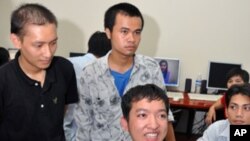Twenty years ago, the U.S. Congress enacted the Americans with Disabilities Act, a sweeping legislation designed to prohibit discrimination against people with disabilities in employment, transportation, public accommodation, communications, and governmental activities.
For many years, groups in Vietnam have been working for similar protections and guarantees from that nation's government. In the second of a two part report, VOA's Jim Stevenson has more on Vietnamese beneficiaries of a similar law for the disabled enacted this year.
Many organizations were involved in the creation of government measures in the years leading to Vietnam's new Disability Law. Ms. Duong Thi Van is the Vice Chair of the Hanoi Disabled Persons Organization.
Her organization helped to create the Barrier Free Codes and Standards in 2002, and the first National Plan of Action on disability from 2006 through 2010.
"The code and standard has been a very useful guidance for the investor in construction areas in Vietnam. Now in many provinces, new building or new construction has been ensured to be accessible for the people with disabilities," she said.
The results are already very visible in Vietnam with access ramps and handrails included in all new building construction.
The overall effort began with the passage of the National Ordinance on People with Disabilities in 1998. A series of initiatives followed to advance the rights and interests of people with disabilities. USAID Mission Director Frank Donovan says the Vietnamese government was very open through the process.
"The law itself was pushed on the government side. And the government did reach out to the peoples with disabilities communities to get input. And there were definitely some major gatherings where people with disabilities expressed their desires, their issues. The government parties then helped include that in the drafting of the law," he said.
The achievements in policy reform and implementation ahead of the law brought direct benefits to more than seven million Vietnamese with disabilities, and indirectly benefitted several million more. With The Vietnam Disability Law, Donovan says the government is now moving to the next step - enforcement.
"All the different parties of the government, the inter-agency government of Vietnamese players, are getting together now to develop implementing regulations to basically make it very precise, when people violate the law and what the penalties are, so that enforcement can then be made," he said.
The new law mandates equal participation in Vietnam's society for people with disabilities through accommodation and access to health care, rehabilitation, education, employment, vocational training, cultural services, sports and entertainment, transportation, public places, and information technology.
The law is expected to have a direct impact on the growth of Vietnam's economy, as inclusive policies expand opportunities for Vietnamese with disabilities to be productive and achieve economic independence.
The impact can immediately be seen as persons with disabilities enter the workforce. Nguyen Van Giap is a Vietnamese student who recently completed a USAID funded IT training program in Hanoi for youth with disabilities. He moves around in a wheelchair, and is now a software engineer. Nguyen finished at the top of his class.
Through an interpreter, he says graduates of USAID training have some choices. "There are two options for the graduate. First is picking up employment, a job with the private IT companies. And the second option is that they get together and form their own group, or their own business, and work on information sharing and have other students with disabilities in many activities," he said.
Information sharing was how Nguyen came to USAID. "I learned about USAID training through my friends. Some of my friends have attended the previous courses on IT and they told me about it," he said.
A vast majority of people with disabilities in Vietnam live in rural areas and attend school at rates far below those of non-disabled persons.
Nearly 37 percent of adults with disabilities are illiterate compared to national rates that are below 10 per cent for non-disabled persons. As a result, few people with disabilities in Vietnam have stable jobs and regular
incomes. Many remain outside of formal employment systems. Most people with disabilities depend on family networks for jobs. Nearly 33 per cent of Vietnamese households with a disabled family member live below the poverty line compared to households without disabled people.
Nguyen Van Giap is hoping to use his experience and technology to reach other disabled persons in rural areas.
"I have been working with some others in my classes to develop a mechanism so that we can provide information, disseminate information as wide as possible for people with disabilities, even from the remote areas. All that information which I have for them, for example, employment opportunities, information about services, and how to have them overcome the difficulties in life. I want everyone to be lucky like me, to know about the program and have opportunities to enroll in such activities," he said.
The Vietnam Assistance for the Handicapped is continuing to work in partnership with the Government of Vietnam as it implements the National Disability Law.







